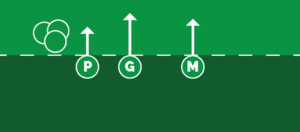If you examine a lot of strength, power, and conditioning programs, you’ll soon notice that most of them are simply designed to induce fatigue. By the end of your workout, you should feel entirely spent, and if you are crippled with DOMS for several days afterward, that’s even better.
While this level of overload can work, it’s a lot like using a sledgehammer to crack a walnut – it’s overkill. The problem with strength training overkill is it wastes a lot of energy and also requires long periods of recovery. That’s why, if you adopt a body-part or “bro” training split, you can only realistically train each muscle group once a week. You need nearly a week to recover.
Triphasic training is much more precise. It breaks human movement down into its three constituent parts – eccentric, isometric, and concentric.
This means you can target weak muscular links one at a time to develop greater strength and power without wasting lots of energy on unnecessarily long workouts. This should also hasten recovery.
This might not have much appeal to the regular gym rat who only wants bigger biceps for the beach. But, for a busy rugger who also has to find time and energy for tram practice and cardio, triphasic training could be very beneficial.
Triphasic training uses a periodized approach workout organization. The first training phase is isometric training.
What is an eccentric contraction?
All dynamic movement begins with an eccentric muscle action. An eccentric contraction occurs as a muscle lengthens under tension. For example, lowering your chest to the floor while doing push-ups is an eccentric contraction. The eccentric phase of movement is like cocking the hammer on a gun or pulling back a rubber band before letting go.
In short, the eccentric action pre-loads your muscles so that they briefly store and then release energy explosively. The more rapid and powerful an eccentric contraction is, the faster and powerful the subsequent concentric or shortening contraction will be. Greater eccentric strength will result in increased concentric performance.
Two powerful processes contribute to eccentric force development, the stretch reflex and the stretch-shortening reflex. These processes are very similar, overlap, and are dependent on each other.
The stretch reflex, also known as the myotatic reflex, is a protective mechanism that prevents overstretching. When you stretch a muscle, sensory organs called muscle spindles monitor muscle length. If a muscle is stretched too quickly, the sensors trigger a contraction to stop the muscle lengthening further. The faster the stretch, the more powerful this braking mechanism becomes.
The stretch-shortening reflex is responsible for the absorption of kinetic energy within the muscle and tendon. The rapid stretching of a muscle results in a forceful counter contraction. Eccentric training affects both of these mechanisms. These reflexes essentially “join” the eccentric phase of a movement to the concentric phase. This is known as coupling.
The positives of negative training
The more force you can handle eccentrically, the more force you’ll be able to generate concentrically. You are also stronger eccentrically than you are concentrically. In other words, you can lower more weight than you can lift.
By emphasizing the eccentric phase of movement, triphasic training allows you purposely overload the eccentric muscle action, and that will have a pronounced effect on muscle performance. The rugger who can handle higher levels of force through an increased stretch reflex will be able to apply more force concentrically. They’ll be able to jump higher, tackle harder, sprint faster, or use more power in other explosive movements.
Eccentric training is simple to implement; you simply lower your weights slowly and under control and then try and lift them as quickly as possible. However, while the concept is straightforward, you should take a few precautions before attempting this type of training.
- Use large, compound exercises – eccentric training is mechanically and neurologically stressful. Spread that stress over several joints and muscle groups by only using compound exercises. In other words, squats are in, leg extensions are out for eccentric training.
- Do eccentric training early in your workout – effective eccentric training depends on a well-rested nervous system. Do eccentric training first, while you are fresh.
- Quality over quantity – eccentric training is very demanding, and you don’t need to do a lot of it to get good results. One or two exercises per muscle group should be sufficient.
- Never use more than 85% of 1RM for slow eccentrics – while your larger prime movers may able to handle more weight, your smaller and weaker synergists and stabilizer muscles may not. Limit your risk of injury by never using more than 85% of your 1RM for eccentric training. See the loading protocol chart below for more details.
- Use a spotter for slow eccentrics – slow eccentrics can cause a lot of fatigue, and muscular failure can occur unexpectedly. Have a spotter on hand to reduce the risk of injury, especially for squats and bench presses.
- Always end a slow eccentric contraction with a fast concentric – while you might not be able to lift a heavy weight quickly, that should always be your intent. This will increase nervous system activation and will reinforce the coupling effect of turning an eccentric contraction into a concentric contraction.
- Rest 2-3 minutes between sets – you might feel recovered sooner, but you should rest 2-3 minutes between sets. This will ensure your nervous system is as ready as your muscles for your next set. Eccentric training takes a lot out of your nervous system and, unless it is fully recovered, you will not be able to generate maximum force.
Loading parameters for eccentric training
The best way to implement eccentric training is to introduce it gradually (preferably during the off-season) and then increase workout demand gradually. Use this chart to determine what weights to use and how long the eccentric phase should be during each rep. Start at the top of the table (least intense) and work downward over the course of several phases of training.
You can apply eccentric training to a wide range of exercises, but the best choices, according to official Triphasic guidelines, are:
- Back squats
- Front squats
- Romanian deadlifts
- Bench press
- Pull-ups
- Shoulder press
For all eccentric exercises you should:
- Adopt the proper setup position, inhale, and brace.
- Maintaining proper joint alignment, lower the weight in the prescribed time.
- On reaching the bottom of the rep, explosively fire the weight back up to the starting position. Exhale as you lift.
- Reset and repeat for the prescribed number of reps.
Here are two example workouts using the eccentric triphasic training method. Not all exercises involve eccentrics. Other exercises are included for muscular balance and exercise variety. Use the loading/tempo/volume that is appropriate to your current phase of training.
Lower body eccentric workout
Upper body eccentric workout
Eccentric training is an effective way to increase concentric strength and power, but it is not without drawbacks. For starters, eccentric training can trigger severe DOMs, partly because of the mechanism of contraction and partly because of the ability to use heavier than normal loads. That’s why we recommend you introduce this training method in the off-season. It’s also tough on your nervous system, and that means you’ll need to pay as much attention to recovery as you do your workouts.
Get yourself fired up for eccentric training with pre-workout and recovery faster with post-game. In article two of this series, we’ll take a look at the next phase in the triphasic trilogy – isometric training.


